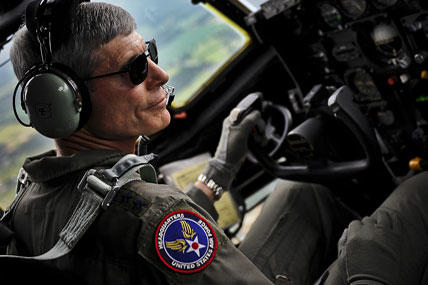Many people inside and outside the Air Force felt the service had lost its way when Gen. Norton Schwartz became its chief of staff in 2008. Airmen had lost track of six nuclear warheads. Top Pentagon leaders accused service officials of focusing more on buying fighter jets built to fight the Soviet Union than the ongoing wars in Iraq and Afghanistan.
Almost four years later, Schwartz looked back on his turbulent tenure Tuesday in his last Pentagon press conference as chief of staff. The Air Force four-star reflected on some of his successes, such as the explosion of remotely piloted aircraft, and some of his failures -- like the loss of trust within Congress following the service’s proposed cuts to the Air National Guard.
Schwartz’s presumed successor, Gen. Mark Welsh, head of U.S. Air Forces in Europe, faces his own set of challenges including budget pressure, but he won’t face the unprecedented upheaval that greeted Schwartz as he walked onstage after then-Defense Secretary Robert Gates sacked the service’s two top leaders.
Schwartz, a career special operations pilot, will finally get to enjoy a retirement Gates asked him to put on hold after finishing his job as head of U.S. Transportation Command. Schwartz will leave his service much different than it was four years ago, before the creation of its unified Global Strike Command and in a time when service leaders worried more about the F-22 Raptor’s production line than its oxygen systems.
Schwartz confronted scrutiny from those inside the service right from the start. Air Force generals howled when he signed off on Gates’ decision to end production of the F-22 at 187 aircraft. Some officers pinned him as a lackey to Gates and criticized him for not standing up and demanding the production line stay open.
“The last four years have been hell for Schwartz. The circumstances in which he got the job gave him little room to maneuver and protect his service,” said defense industry consultant Loren Thompson of the Lexington Institute.
Those who knew Schwartz knew Gates had selected the right Air Force officer to take command, said retired Gen. Frank Klotz, the first commander of Global Strike Command.
When asked why he selected Schwartz, Gates highlighted his leadership record at Special Operations Command, U.S. Transportation Command and inside the Pentagon. Klotz said Schwartz’s success leading a joint combatant command helped him win over those skeptical about Gates’ nomination.
“The credibility of the Air Force had been severely undermined,” Klotz said. “I think he brought to the job an incredible amount of credibility from those inside the Air Force as well as the other services,” Klotz said.
In his first year, he oversaw major changes, including the stand-up of Global Strike Command. Not since the Cold War had the service’s nuclear mission been organized under one command. Schwartz also made sure to install a more rigorous inspection process for his service’s nuclear units, even though the tougher tests yielded more poor marks, causing more negative headlines.
Stinging reviews of the Air Force’s nuclear arm demanded a nuclear culture change. Klotz said Schwartz achieved this in a small but meaningful way. He convinced every airman that her or his job was important.
Schwartz reiterated that point Tuesday, pointing out how his “All In” campaign was vital in the early days to show the service’s commitment to the wars in Iraq and Afghanistan. As the first non-fighter pilot selected to lead the service since 1982, he emphasized the importance of airmen coming together.
“All of us come from someplace. We all grow up somewhere in a discipline or a part of our Air Force and we are damn proud of where we come from, but the issue is that as one becomes more senior that you have to become bigger than where you came from -- and that was an essential message,” Schwartz said. “In addition, it was the plain fact that everyone in our Air Force counts. Everybody contributes and that was part of the basis for the ‘All In’ campaign in the early days and something I believe will stick.”
The “All In” campaign seemed to grow out of the criticism the Air Force did not move quickly enough to deploy drones and intelligence, surveillance and reconnaissance aircraft over Iraq and Afghanistan. Over Schwartz’s tenure, the number of combat air patrols over Iraq and Afghanistan exploded to well over 50. He also oversaw Project Liberty, in which engineers took civilian turboprop aircraft, rigged them with intelligence sensors, and deployed them to Iraq and Afghanistan in months.
The Army gets plenty of credit for rushing Mine Resistant Ambush Protected vehicles into combat. Defense analysts said Schwartz and his team might not get quite enough credit for their flood of ISR aircraft they sent to the war zone.
“In the period since Schwartz became chief, the Air Force has pushed out both the number of CAPs but also the amount of actual usable ISR in a major, major way,” said Peter Singer, director of 21st Century Defense Initiative at the Brookings Institution.
Questions still remain over Schwartz’s handling of the service’s transition to fifth-generation fighters. He took the keys to the last F-22 off the production line even as the Defense Department tries to protect its F-35 Lightning II program from creeping budget austerity.
The service is committed to “buying as many F-35s as the country can afford,” Schwartz said.
Other acquisition issues served as a constant challenge for Schwartz. He finally harpooned the white whale now known as the KC-46A tanker, but only after years of Beltway combat and hand-wringing over the service’s many failures throughout the process. Pain still shows in Schwartz’s face when he describes how Air Force officials delayed the fielding of a Light Air Support aircraft for Afghanistan because of paperwork errors.
Schwartz’s tenure will also finish with the Air Force embroiled in an embarrassing sexual assault scandal at Lackland Air Force Base, Texas, which has rocked the service and forced Welsh to admit it has made little progress toward curbing the crime.
As for Schwartz, Klotz said he and his classmates could tell Schwartz was destined for a decorated Air Force career even back at the Air Force Academy. Klotz described how Schwartz’s work ethic and leadership skills prompted academy commanders to assign Schwartz to lead the squadron filled by cadets who struggled with the transition to academy life.
“We could tell back then,” Klotz said.
Almost 40 years later, Schwartz will complete the career that many of his academy alums predicted for him and could now make good on the retirement plans he has long promised to his wife, Suzie. When asked if he was glad he postponed those plans, he briefly paused before answering.
“I’ll tell you when I make it to Hawaii.”


























